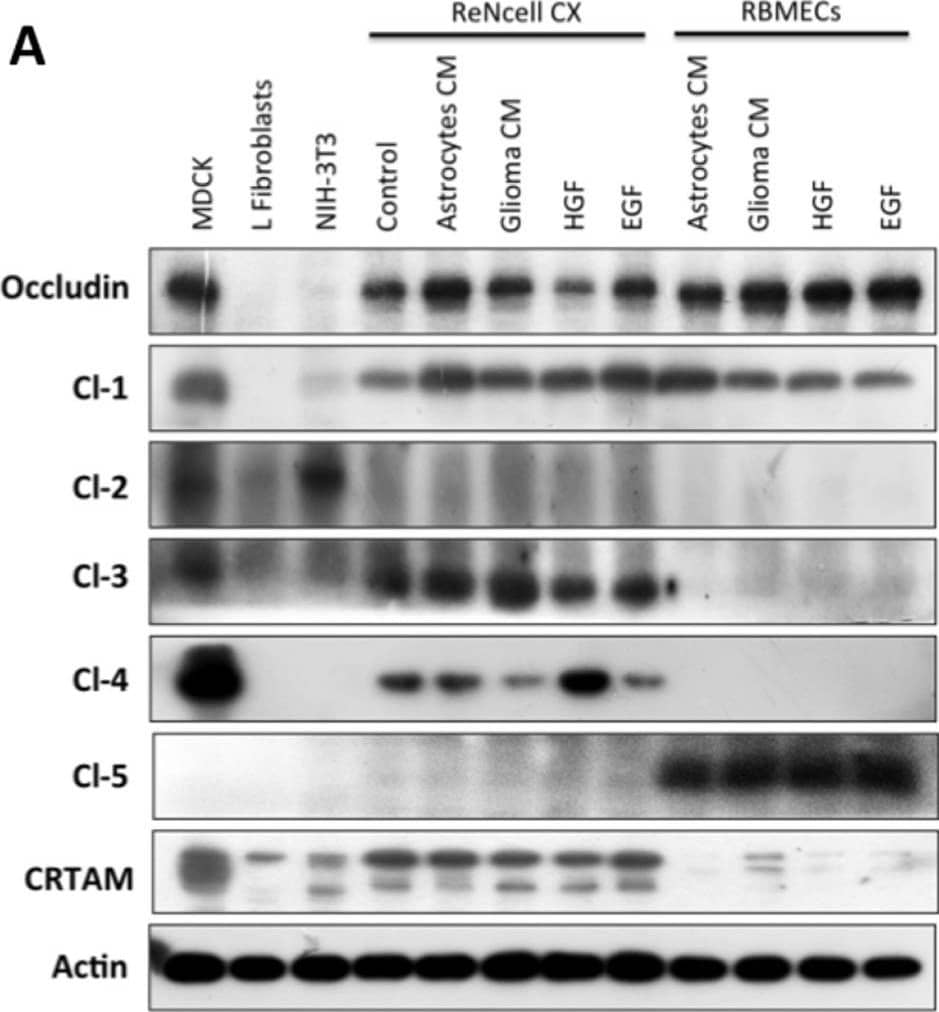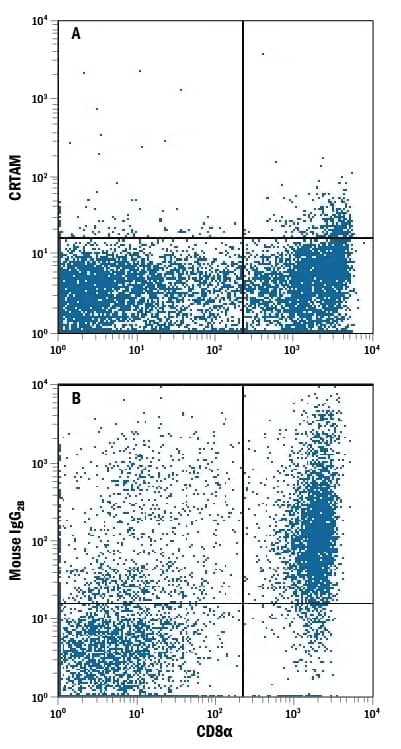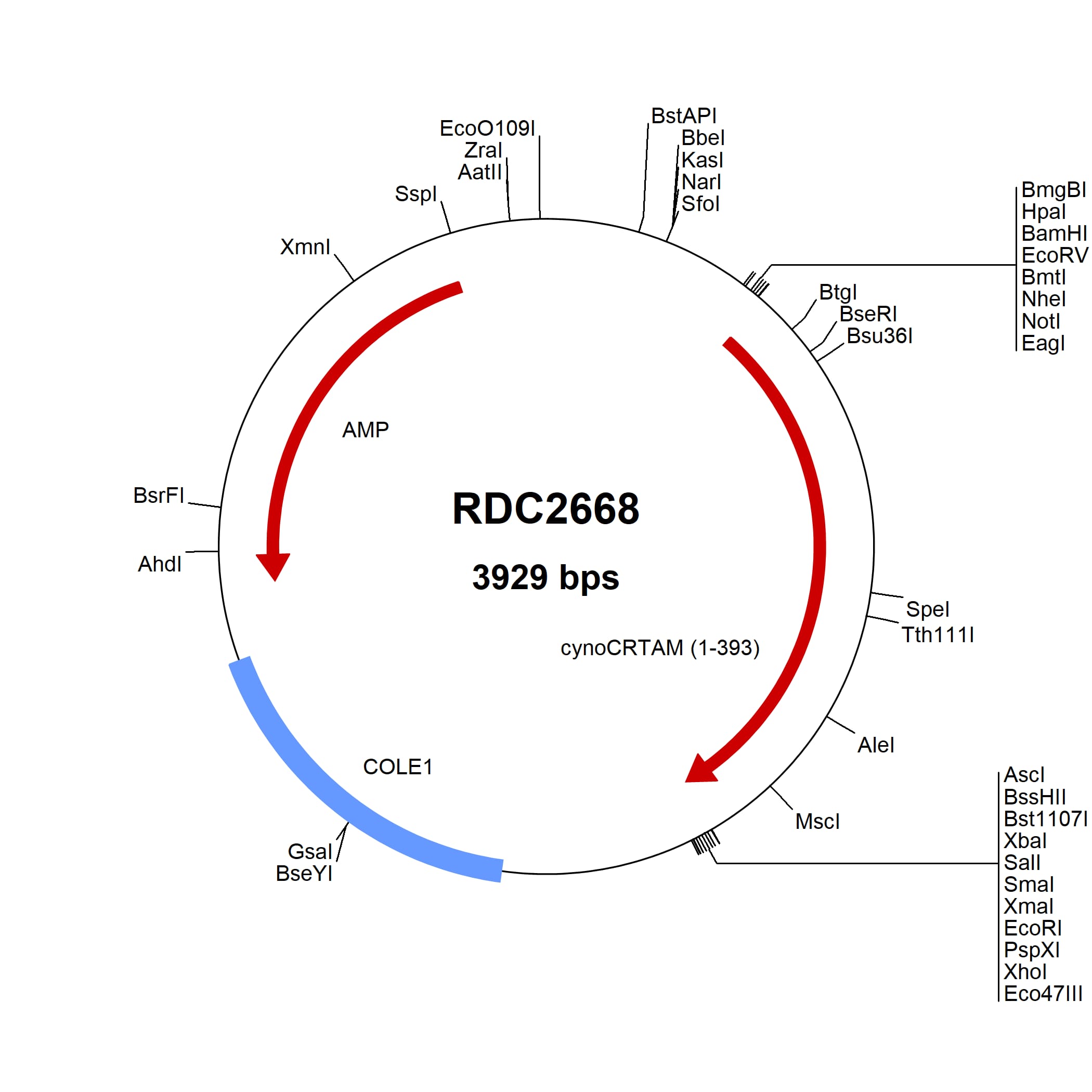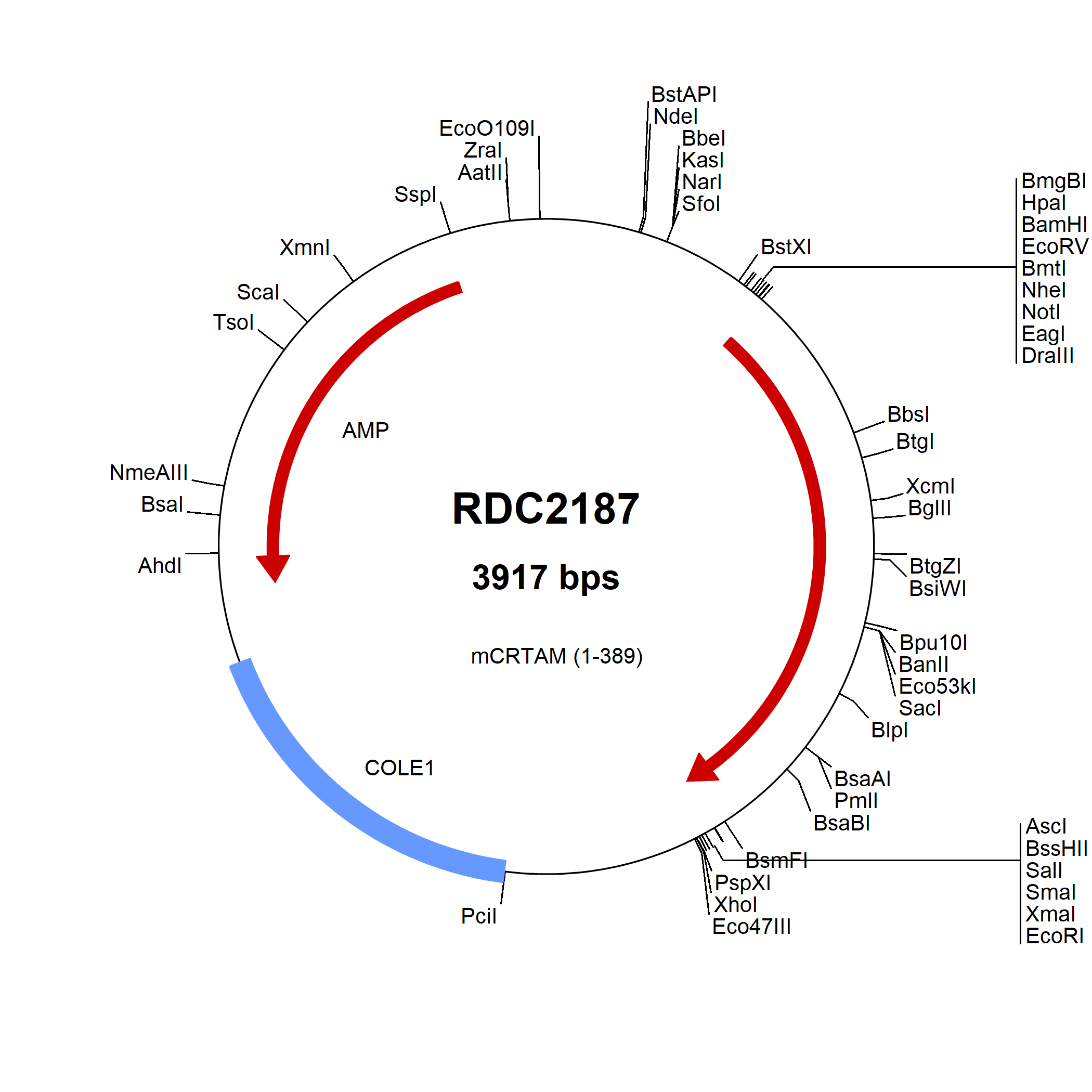CRTAM Products
CRTAM (Class I-restricted T cell-associated molecule) is a nectin family member of the immunoglobulin superfamily that is expressed by activated CD8+ and NK T cells. NK activation receptor engagement, but not cytokines, also induce NK CRTAM expression. CRTAM is found in spleen, thymus, small intestine, peripheral blood, and in brain where it is highly expressed by Purkinje cells of the cerebellum.
Human CRTAM is a 393 amino acid (aa), 80 kDa type I transmembrane glycoprotein. CRTAM is a homodimer on the cell surface but does not show homotypic binding in trans. The high affinity of CRTAM/IGSF4 adhesion allows CRTAM to disrupt IGSF4 homotypic interactions. IGSF4 and T cell receptor co-engagement of CRTAM-expressing CD8+ cells induces increased IFN-gamma or IL-22 production. A role in cancer surveillance through NK cell-mediated rejection of IGSF4-expressing tumors has been proposed. IGSF4 is expressed broadly, including on epithelia, neurons, a subset of tonsillar B cells and a rare splenic T zone-restricted BCDA3+ dendritic cell population which interacts with CRTAM.
74 results for "CRTAM" in Products
74 results for "CRTAM" in Products
CRTAM Products
CRTAM (Class I-restricted T cell-associated molecule) is a nectin family member of the immunoglobulin superfamily that is expressed by activated CD8+ and NK T cells. NK activation receptor engagement, but not cytokines, also induce NK CRTAM expression. CRTAM is found in spleen, thymus, small intestine, peripheral blood, and in brain where it is highly expressed by Purkinje cells of the cerebellum.
Human CRTAM is a 393 amino acid (aa), 80 kDa type I transmembrane glycoprotein. CRTAM is a homodimer on the cell surface but does not show homotypic binding in trans. The high affinity of CRTAM/IGSF4 adhesion allows CRTAM to disrupt IGSF4 homotypic interactions. IGSF4 and T cell receptor co-engagement of CRTAM-expressing CD8+ cells induces increased IFN-gamma or IL-22 production. A role in cancer surveillance through NK cell-mediated rejection of IGSF4-expressing tumors has been proposed. IGSF4 is expressed broadly, including on epithelia, neurons, a subset of tonsillar B cells and a rare splenic T zone-restricted BCDA3+ dendritic cell population which interacts with CRTAM.
Recombinant Monoclonal Antibody
| Reactivity: | Human |
| Details: | Human IgG1 Monoclonal Clone #Oxford Bio patent anti-CRTAM |
| Applications: | ELISA, Flow, Func |
Recombinant Monoclonal Antibody
| Reactivity: | Human |
| Details: | Human IgG1 Monoclonal Clone #Oxford Bio patent anti-CRTAM |
| Applications: | ELISA, Flow, Func |
Recombinant Monoclonal Antibody
| Reactivity: | Human |
| Details: | Human IgG1 Monoclonal Clone #Oxford Bio patent anti-CRTAM |
| Applications: | ELISA, Flow, Func |
Recombinant Monoclonal Antibody
| Reactivity: | Human |
| Details: | Human IgG1 Monoclonal Clone #Oxford Bio patent anti-CRTAM |
| Applications: | ELISA, Flow, Func |
Clone 210213 was used by HLDA to establish CD designation
| Reactivity: | Human |
| Details: | Mouse IgG2b Monoclonal Clone #210213 |
| Applications: | WB, Flow, CyTOF-ready |
| Reactivity: | Human |
| Details: | Mouse IgG1 Monoclonal Clone #210206 |
| Applications: | WB |
Clone 210213 was used by HLDA to establish CD designation
| Reactivity: | Human |
| Details: | Mouse IgG2b Monoclonal Clone #210213 |
| Applications: | Flow |
| Reactivity: | Human |
| Details: | Goat IgG Polyclonal |
| Applications: | WB |
Clone 210213 was used by HLDA to establish CD designation
| Reactivity: | Human |
| Details: | Mouse IgG2b Monoclonal Clone #210213 |
| Applications: | Flow |
| Reactivity: | Human |
| Details: | Goat IgG Polyclonal |
| Applications: | WB |
| Source: | NS0 |
| Accession #: | O95727 |
| Applications: | Bind |
| Assay Range: | 156 - 10,000 pg/mL |
| Applications: | ELISA |
Clone 210213 was used by HLDA to establish CD designation
| Reactivity: | Human |
| Details: | Mouse IgG2b Monoclonal Clone #210213 |
| Applications: | Flow |
Clone 210213 was used by HLDA to establish CD designation
| Reactivity: | Human |
| Details: | Mouse IgG2b Monoclonal Clone #210213 |
| Applications: | Flow |
| Source: | NS0 |
| Accession #: | Q149L7.1 |
| Applications: | Bind |
Clone 210213 was used by HLDA to establish CD designation
| Reactivity: | Human |
| Details: | Mouse IgG2b Monoclonal Clone #210213 |
| Applications: | Flow |
| Reactivity: | Human |
| Details: | Mouse IgG1 Monoclonal Clone #1C11E10 |
| Applications: | WB, ELISA, Flow |
Clone 210213 was used by HLDA to establish CD designation
| Reactivity: | Human |
| Details: | Mouse IgG2b Monoclonal Clone #210213 |
| Applications: | Flow |
Clone 210213 was used by HLDA to establish CD designation
| Reactivity: | Human |
| Details: | Mouse IgG2b Monoclonal Clone #210213 |
| Applications: | Flow |
Clone 210213 was used by HLDA to establish CD designation
| Reactivity: | Human |
| Details: | Mouse IgG2b Monoclonal Clone #210213 |
| Applications: | Flow |
Clone 210213 was used by HLDA to establish CD designation
| Reactivity: | Human |
| Details: | Mouse IgG2b Monoclonal Clone #210213 |
| Applications: | Flow |
| Reactivity: | Human |
| Details: | Mouse IgG Polyclonal |
| Applications: | WB |











![Flow Cytometry: CRTAM Antibody (1C11E10) [NBP3-27154] -](https://resources.bio-techne.com/images/products/nbp3-27154_mouse-crtam-mab-1c11e10-bsa-free-1042024917044.jpg%3Fv=1666704393)

![Western Blot: CRTAM Antibody [H00056253-B01P] Western Blot: CRTAM Antibody [H00056253-B01P]](https://resources.bio-techne.com/images/products/CRTAM-Antibody-Western-Blot-H00056253-B01P-img0002.jpg)